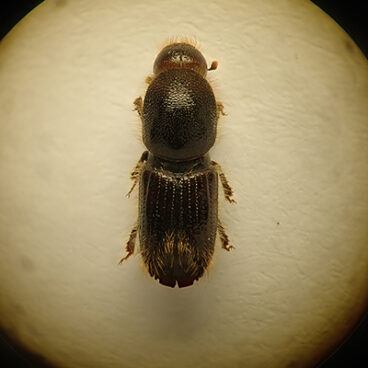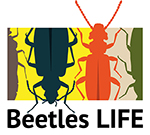Several insect species new to Finland have been discovered in the species surveys of the Beetles LIFE project, which is conducted by Metsähallitus, National Parks Finland. The surveys also revealed a great deal of new information on poorly known and threatened species. Interesting species findings were made especially in the Kakonsalo area in Savonlinna, Ruunaa in Lieksa, Koitajoki in Ilomantsi, Oulanka in Kuusamo, and Elimyssalo in Kuhmo.
– Most of the new insect species that are found in Finland each year are southern species that have migrated further north. The species found by the Beetles LIFE project between North Karelia and Kainuu regions are not such species, and several of them may have been among us for a long time before they were detected today, says Sampsa Malmberg, Conservation Specialist.
The EU-funded project has carried out surveys and monitoring activities focusing on beetles, hemipterans, dipterans and hymenopterans at 16 different Natura sites, most of which lacked any meaningful information on the species of the insect orders in question. The samples were collected in 2018 and 2020–2022, and the latest identifications of the survey materials were completed in spring 2023.
An unexpected beetle finding: “Identifying it was a real headache”
One of the most surprising findings was made in Savonlinna: Byrrhus geminatus, a species of pill beetle in the family Byrrhidae. Finding the species in Finland was a surprise, as there have been no observations of it in any neighbouring areas, and not much in Europe as a whole. The species is mostly found in North America, Russia and a few Asian countries.
– Identifying the species was a real headache, because it is not mentioned in European beetle identification literature. I had to call abroad and ask a Byrrhidae specialist for help, who instantly recognised the species, Sampsa Malmberg explains.
Byrrhidae are hard, circular and slow-moving beetles whose larvae mainly feed on moss. The newly found Byrrhidae in Finland is one of the largest of its family in Finland, measuring up to 1 cm in length.
New hymenopteran species in Finland
The material examined this spring revealed at least two new species of Hymenoptera in Finland. Schizopyga flavifrons was found in the Ruunaa region in Lieksa. Meteorus sibyllae, a new species to Finland, was recorded in Koitajoki, but it was then revealed that the species had already been detected for the first time in 2018 – and even more interestingly, both observations were made at Metsähallitus’ controlled burning sites. The Hymenoptera species were determined by Hymenoptera Expert Juuso Paappanen.
Vast majority of Hymenoptera, including these newly found species, are parasites of other insects or spiders. Parasitic Hymenoptera play an important role in nature, as they effectively regulate other insect’s populations.
There are species hiding in Finland that we do not yet know
More than 15 new species of flies new to Finland have been found in the Beetles LIFE project, and some of these findings have been publicised before. Recently, several new species have been found in Finland, especially in the sizable yet poorly known Phoridae family. For example, the Phoridae species Megaselia altezza, which is previously mainly known from Central Europe, was now recorded even at four different sites across Finland.
– This species has apparently been widespread here for a long while now, but no one had identified it before. By focusing on poorly known insect groups, we can discover this kind of new information, says Sampsa Malmberg.
More than 26,000 species of insects are known from Finland, but there are plenty of species yet to be discovered.
Valuable information about threatened species
Although new species findings and discoveries represent the most prominent surprises of extensive species surveys, their most important purpose is to provide information on threatened and near-threatened species. Based on new occurrence and monitoring data on threatened species, it is possible to protect species more efficiently, for example through controlled burnings at specific sites and by supporting the regeneration of aspens. Monitoring data on threatened species also helps us assess the state of our species, forests and entire natural world.

One happy surprise was the discovery that Ips sexdentatus, an old-growth forest species that has been classified as endangered (EN) and which disappeared from nearly all of Finland during the last century, was still present in at least the Elimyssalo Natura site in Kuhmo. It was found from one of the project’s controlled burning site. The species was last detected in Finland 20 years ago. In the first half of the 20th century, Ips sexdentatus widespread throughout Finland, but its population soon declined rapidly. The species thrives especially under the bark of dead sturdy pines and in the dead pines found in forest fire areas.
New information on poorly known insect species
The surveys have yielded a considerable amount of new information on poorly known insect species, especially such dipterans and hymenopterans whose conservation status has never been assessed due to a lack of data. When sufficient information is obtained on the occurrence and habitats of these species in Finland, their conservation status can also be assessed in the future.
The Beetles LIFE project and its surveys have been made possible by the LIFE funding granted by the EU. The project focuses on a number of conservation measures, such as restoring forests and supporting species that rely on forest fires through controlled burnings; promoting the regeneration of aspens, which are very important for biodiversity; securing dead wood continuum; and restoring woodlands. These measures benefit hundreds of species in our forests, including many threatened insects. Restoration means restoring a human-modified habitat as close to its natural state as possible. Many forest species have become threatened due to the decrease in old-growth forests, aspens, decaying wood, and natural forest fires.
Further information:
Sampsa Malmberg, Conservation Specialist, National Parks Finland: sampsa.malmberg@metsa.fi, tel.int. +358 40 583 9648
- Beetles LIFE project
- Researchers find 3 previously-unknown fly species in Finnish forests (Yle News 19 September 2022)
- Beetles Life project’s insect surveys reveal previously unknown species of flies (press release, 19 September 2022, available in Finnish only

